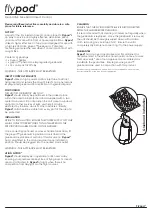
24
A voltage of around .6V is required across the base emitter junction of a transistor to begin
to turn it on. Since a total of 4 junctions are in the current amp (Q2, Q1, Q13, and Q12) the
bias reference needs to have around 2.4V (4 drops) across it to turn on all four transistors
in the current amplifier.
The range of adjustment is very small (Between 1.7V and 2.8V when VR1 adjustment from
stop to stop). The reason the adjustment range is small, is because very little change in
voltage across the reference produces radical bias current changes in the output stage
(Due to the logarithmic relationship between base emitter voltage to collector current). Too
great a range results in a control that is very hard to adjust.
As a transistor heats up it requires less and less base emitter voltage to obtain the same
collector current. If the bias reference voltage remains constant, and the output and driver
transistors begin to heat up, the current amp will draw more and more current, eventually
destroying itself. This is why the reference transistor, Q5 is mounted to the heatsink: As
the outputs (Q1, Q13) and drivers (Q2, Q12) heat up so does Q5. This action regulates the
output bias current and keeps it constant with temperature.
a.
Excessive power pulled from AC line.
This is due to excessive voltage across reference. The range (measure across C12)
should be 1.7V to 2.8V. If not check R13, VR1, R14, and Q5.
b.
Crossover distortion in output waveform.
This is due to inadequate voltage across reference. The range (measure across C12)
should be 1.7V to 2.8V. If not check R13, VR1, R14, and Q5.
After amplifier heats up, bias current, and power pulled from AC line, increases.
This is due to the fact that the bias circuit not tracking the current amplifier with temperature.
Make sure that all of the transistors, Q1, Q2, Q5, Q12, and Q13, make good thermal con-
tact with the heatsink (Hardware is tight, adequate thermal grease is on devices, insulators,
and heatsink). If all of this is OK replace Q5.
I)
Voltage Amp Test
Turn Generator A off. Lift one side of R12. Connect base of Q10 to base of Q11. Power
up amplifier. Verify that the voltage at collector of Q15 is around zero volts. If not, refer to
“Amplifier Muting Test”.
1.
Front End and Current Source
Verify 1.2V across anode of D10 to cathode of D11. If incorrect check D10, D11, R32, R31
and Q14. Verify voltage across R31 (600mV). Verify resistance of R31 (620 ohms).
The voltage at the collector of Q14 should be –6V. If the voltage is subsequently lower look
for short from collector to emitter of Q14.
Содержание EON Power10
Страница 23: ...High Frequency Response EON Power15 and EON15P 1 230 33 ...
Страница 24: ...Low Frequency Response EON Power15 and EON15P 1 230 34 ...
Страница 30: ...Low Frequency Response EON PowerSub 40 ...
Страница 35: ...High Frequency Response EON Power10 45 ...
Страница 36: ...Low Frequency Response EON Power10 46 ...















































